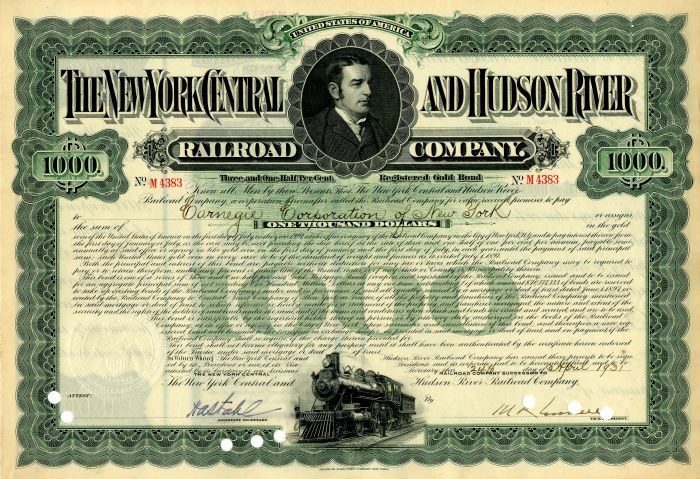New York Central and Hudson River Railroad Co. issued to Carnegie Corporation of New York - 1931 dated $1,000 Bond
Inv# AG2208A Bond
$1,000 3 1/2% Gold Bond issued to Carnegie Corporation of New York.

Andrew Carnegie (1835-1919) Industrialist; Philanthropist. Shortly after immigrating to the U.S. from Scotland, Carnegie became private secretary to Thomas A. Scott who was just beginning his career with the Pennsylvania Railroad. Carnegie worked for Scott during the latter's position as chief of railroad transportation for the Union during the Civil War and, at the end of the conflict, left Scott to build a successful business in the sales of railroad securities, oil brokering and bridge building. In 1873 Carnegie moved into the emerging steel industry, and he and his partners were responsible for making the U.S. steel industry the world leader by the turn of the century. After selling his enterprises to J.P. Morgan's U.S. Steel in 1901, he spent the remainder of his life traveling and supporting his various philanthropies.
Among all of his many philanthropic efforts, the establishment of public libraries in the United States, the United Kingdom, and in other English-speaking countries was especially prominent. Carnegie libraries, as they were commonly called, sprang up on all sides. The first of which was opened in 1883 in Dunfermline, Scotland. His method was to build and equip, but only on condition that the local authority provided site and maintenance. To secure local interest, in 1885, he gave $500,000 to Pittsburgh for a public library, and in 1886, he gave $250,000 to Allegheny City for a music hall and library, and $250,000 to Edinburgh, Scotland, for a free library. In total Carnegie funded some 3,000 libraries, located in every U.S. state except Alaska, Delaware and Rhode Island. Carnegie also built libraries overseas in Britain, Ireland, Canada, Australia, New Zealand, the West Indies, and Fiji.
He gave $2 million in 1901 to start the Carnegie Institute of Technology at Pittsburgh and the same amount in 1902 to found the Carnegie Institution at Washington, D.C. He would later contribute more to these and other schools. CIT is now Carnegie Mellon University. He owned Carnegie Hall in New York City from its construction in 1890 until his widow sold it in 1924. By the time he died in Lenox, Massachusetts, Carnegie had given away $350,695,653. At his death, the last $30,000,000 was likewise given away to foundations, charities and to pensioners. Read more at https://en.wikipedia.org/wiki/Andrew_Carnegie
The New York Central Railroad (reporting mark NYC) was a railroad primarily operating in the Great Lakes and Mid-Atlantic regions of the United States. The railroad primarily connected greater New York and Boston in the east with Chicago and St. Louis in the Midwest along with the intermediate cities of Albany, Buffalo, Cleveland, Cincinnati, Detroit, and Syracuse. New York Central was headquartered in New York City's New York Central Building, adjacent to its largest station, Grand Central Terminal.
The railroad was established in 1853, consolidating several existing railroad companies. In 1968 the NYC merged with its former rival, the Pennsylvania Railroad, to form Penn Central. Penn Central went bankrupt in 1970 and merged into Conrail in 1976. Conrail was broken up in 1998, and portions of its system were transferred to CSX and Norfolk Southern Railway, with CSX acquiring most of the old New York Central trackage. Read more at https://en.wikipedia.org/wiki/New_York_Central_Railroad
A bond is a document of title for a loan. Bonds are issued, not only by businesses, but also by national, state or city governments, or other public bodies, or sometimes by individuals. Bonds are a loan to the company or other body. They are normally repayable within a stated period of time. Bonds earn interest at a fixed rate, which must usually be paid by the undertaking regardless of its financial results. A bondholder is a creditor of the undertaking.









Ebay ID: labarre_galleries